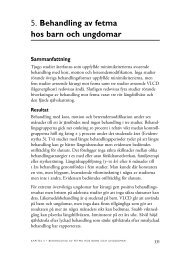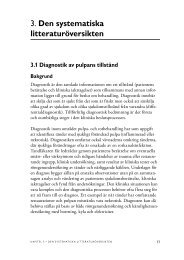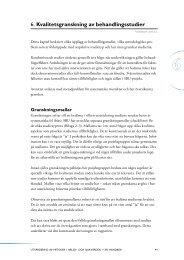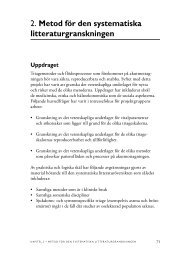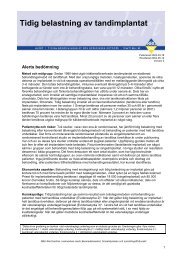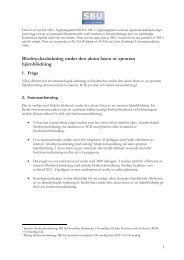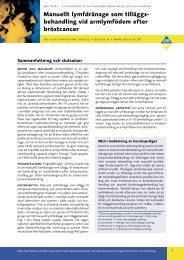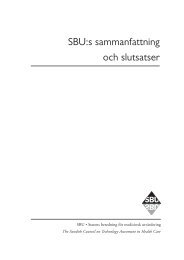Rapporten - SBU
Rapporten - SBU
Rapporten - SBU
Create successful ePaper yourself
Turn your PDF publications into a flip-book with our unique Google optimized e-Paper software.
Table 5.21 continued<br />
Author<br />
Year<br />
Reference<br />
Country<br />
Tobias<br />
2009<br />
[2]<br />
United Kingdom<br />
Material<br />
Analysis method<br />
Voluntary students with ASD were<br />
asked to participate in two focus groups<br />
and parents to all students with ASD in<br />
two grades were asked to participate in<br />
another focus group<br />
The aims were to define what support<br />
had been most helpful, and to consider<br />
what additional support could be<br />
provided<br />
The groups were videoed, the dialogues<br />
taped and transcribed and analysed with<br />
interpretative phenomenological analysis<br />
(IPA)<br />
Emerged themes were grouped into<br />
master themes spanning for all three<br />
groups<br />
The student groups were activity-based<br />
on questions of imaginary boys with<br />
ASD and to compile a toolbox to help<br />
them during school day<br />
Informants Results Summary Study quality<br />
Comments<br />
10 children and 5 parents; two groups<br />
with 3 students from year 11 and 7<br />
students from year 9. All had ASD and<br />
were linked to a support centre within<br />
the mainstream secondary school and<br />
one group with 5 parents to some of<br />
the participating students<br />
AS = Aspergers syndrome; ASD = Autism spectrum disorder; DSM-IV = Diagnostic and<br />
statistical manual of mental disorders, fourth version<br />
360 Autismspektrumtillstånd – diAgnostik och insAtser,<br />
KAPITEL 5 • sysTEmATIsK LITTErATurövErsIKT –<br />
361<br />
vårdens orgAnisAtion och pAtientens delAktighet<br />
Aspects of current sup-<br />
port evaluated positively<br />
by participants:<br />
• Targeted support at key<br />
transition points<br />
• The provision of mentors<br />
for students<br />
• The availability of quiet,<br />
calmer spaces to reduce<br />
anxiety<br />
• Good communication be-<br />
tween staff and parents<br />
• Staff have a good knowledge<br />
of ASD and of<br />
individual students<br />
• Individual, tailor-made<br />
support<br />
• A welcoming ethos<br />
• Thoroughness<br />
• Lower student/staff ratios<br />
Possibilities for additional<br />
support:<br />
• To develop an enhanced<br />
self-confidence and selfawareness<br />
• To develop a sense of<br />
belonging and social<br />
inclusion<br />
• To develop greater<br />
independence and<br />
organisational ability<br />
• To develop life-skills, with<br />
which to negotiate the<br />
“real world”<br />
pAtientens delAktighet vid Ast<br />
Implementing good transition sup-<br />
port, providing students with the<br />
opportunity to talk to a mentor<br />
figure at school and meeting the<br />
needs of individuals rather than<br />
applying blanket policies to groups<br />
of students with ASD, are all per-<br />
ceived as positive strategies<br />
The ethos of a school and the<br />
quality of its communication<br />
with parents are also extremely<br />
important<br />
Additional support to achieve<br />
better self-awareness<br />
Moderate<br />
A small-scale study with<br />
a small group of people<br />
in a single setting<br />
No gender, socioeconomic<br />
information of the<br />
students or the parents<br />
and no description of the<br />
ASD handicap<br />
No ethic discussion<br />
or approval



